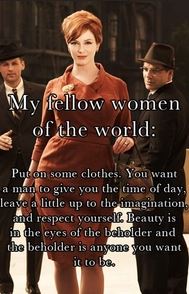Hi! I apologize for my long hiatus, but I’m back and better than ever! For the next few weeks, you will be seeing posts titled “ART 302,” these will be assignments for my Social Aspects of Fashion class, you are more than welcome to partake in the discussion. The reading material I’m using in this particular post is The Dressed Body by Joanne Entwistle.
- In your social group, what are the structural norms for dressing? How are these norms embodied? If you were going to change the norms in your group how would you do so?
I consider my social group as middle class. I grew up in an average middle class home and now as a young married student, I consider my husband and I as lower middle class. People often assume that lower middle class (or lower class) people are uneducated, sloppy, and brass. In our situation it’s quite the opposite. Although we live in a tiny one bedroom apartment, minimal earthly materials and struggle to pay bills on time. My husband and I are educated, active in our religion, responsible and respectable people. Because I was raised in average middle class, I personally hold myself to a higher standard when it comes to dressing and interactions with other people. You will not find me wandering the grocery store in my pajama pants, and/or using fowl language. (But for the record, there are very lovely lower class people out there.) The structural norms for dressing for my social group can range from conservative modesty to a well coordinated, stylish outfit. In all cases the outfits fit the situation (i.e. conservative outfit for church, professional outfit for work.) If I had the opportunity to encourage people of middle lower class people, I would encourage them to expect more of them selves, dress to impress! Dress a class above yourself. If you think more of yourself, people will do the same. In The Dressed Body (pg35), it says that when “we dress we do so to make our bodies acceptable to a social situation.” So leave your pajama pants at home, respect yourself. Show people that you’re worth something.  2. In what social situation were you embarrassed because of something you wore? How did this situation affect future choices?
2. In what social situation were you embarrassed because of something you wore? How did this situation affect future choices?
Oh, this is easy. Last weekend, before my husband and I went out to dinner, he mentioned he wanted me to show a little cleavage. I chose a top that I haven’t worn in a while and this particular top usually requires an undershirt to cover my bodacious ta-ta’s. But this time, I chose not to wear an under shirt. For my husband, I felt sexy. But the moment we arrived at the restaurant, I instantly felt self-conscience. I see myself as a conservative person, so this was a huge thing for me to be wearing in public. The hostess sat us at a booth that was a few steps higher than the rest of the restaurant, it made me feel like my boobs were on display. I tried hiding myself with the menu, but that didn’t stop the glances of boyfriends and husbands at other tables (Yes I saw you!) I’m not going to post a photo, because I don’t want my family to see this “Pamela Anderson-esq” moment. I learned my lesson, If I’m going to wear that top for my husband, it’s going to be in the safety and privacy of our home. On page 40 of The Dressed Body, it brings to mind how women used to deal with corsets. Just looking at them, you would see a beautiful woman while the social constraints of the corset. But you really didn’t know how the woman on the inside was feeling.
3. How do you perceive your body? Passive or Political? Please provide an example of why you think it is passive or political.
What a woman wears says a lot about herself. Even if it’s unintentional, it says a lot about the wearer. I personally see my style leaning towards Political/Active. Although there are moments when I’m relaxed and could care less, most of the time I dress to make an influence. As a Christian woman who appreciates and loves good style, I dress modestly but also coordinated impeccably. Even though it’s cheesy, I’m proud to say that I was voted “Best Dressed” in High School. I believe by dressing modestly and stylishly, you are telling the world that you respect yourself and you expect the world to respect you.


